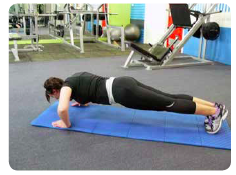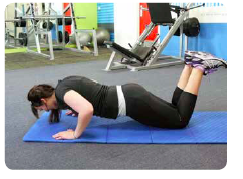Purpose of test:
To assess upper body muscular endurance (Mackenzie, 2005).
Test procedure:
The protocols for the Maximal Push Up Test and the Modified Push Up Test are as follows:-
Push-Up Test (Completed with the client on their toes)
• ‘Lie on the mat, hands shoulder-width apart & fully extend the arms.
• Lower the body until the elbows reach 90 degrees.
• Return to the starting position with the arms fully extended.
• The feet are not to be held for the client.
• The push up action is to be continuous with no rest.
• Complete as many press-ups as possible.
• Record the total number of full body press-ups’ (Mackenzie, 2005).

Modified Push-Up Test (Completed with the client on their knees; o”en used for
females and clients with reduced upper body strength)
• ‘Lie on the mat, hands shoulder width apart, bent knee position & fully extend the arms.
• Lower the upper body until the elbows reach 90 degrees.
• Return to the starting position with the arms fully extended.
• The feet are not to be held for the client.
• The push up action is to be continuous with no rest.
• Complete as many modified press-ups as possible.
• Record the total number of modified press-ups’ (Mackenzie, 2005).

American College of Sports Medicine (2006) guidelines for the Push Up Test protocol are as follows:
1.With male clients, utilize the standard ‘down’ position, using the toes as the pivotal point.
The hands are shoulder width apart, the back is straight, and the head is up. With female
clients, use the modified ‘knee push-up’ position, with hands shoulder width apart, back
straight, legs together, lower legs in contact with the mat, ankles plantar flexed and head
up.
2.Have the client raise the body by straightening the arms and then return to the starting
position, touching the chin to the mat. The stomach should not touch the mat at any
time.
3.Instruct both men and women that the back must be straight at all times and the pushup
must be to a straight-arm position.
4.Count the maximal number of push-ups performed in good form without rest. Stop the
test when the client cannot maintain good form on two consecutive reps, or strains
forcibly and cannot continue.
(ACSM, 2006).
Mackenzie, B., (2005). 101 performance evaluation tests. London, England: Jonathan Pye.
American College of Sports Medicine (ACSM). (2006). ACSM’s guidelines for exercise testingand prescription (7th ed.). Munice, IN: Lippincott Williams & Wilkins